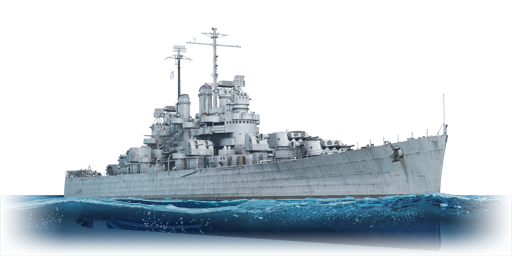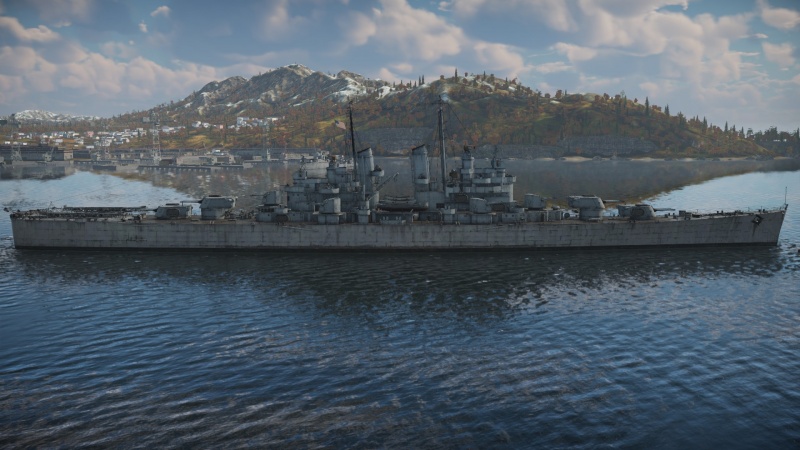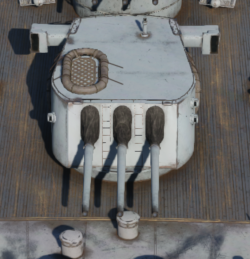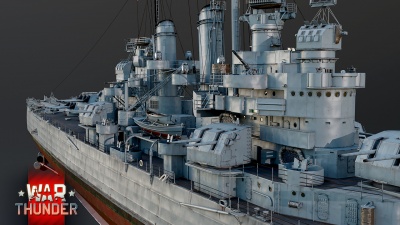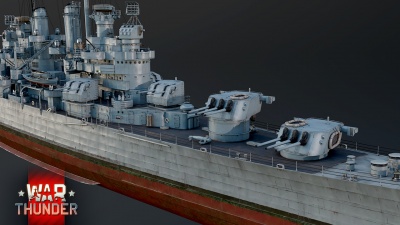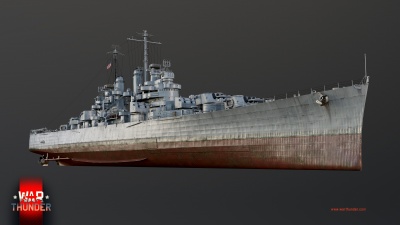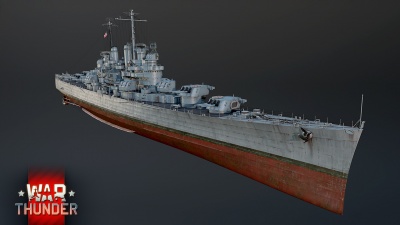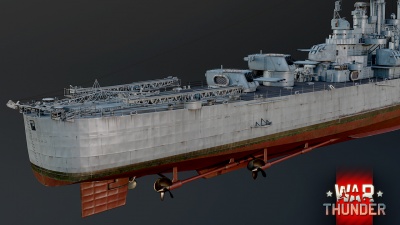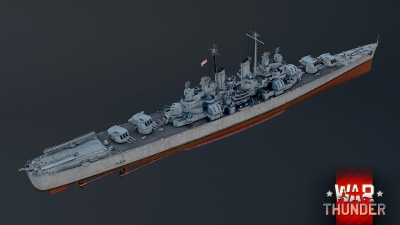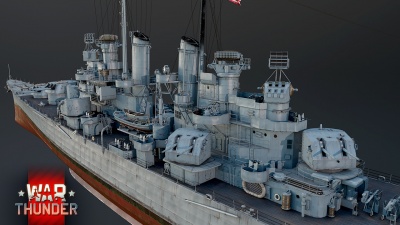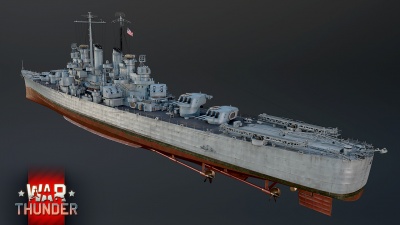USS Cleveland
Contents
Description
The Cleveland-class, USS Cleveland (CL-55), 1942 is a rank V American light cruiser with a battle rating of 6.0 (AB/RB/SB). It was introduced in Update "Starfighters".
General info
Survivability and armour
Talk about the vehicle's armour. Note the most well-defended and most vulnerable zones, e.g. the ammo magazine. Evaluate the composition of components and assemblies responsible for movement and manoeuvrability. Evaluate the survivability of the primary and secondary armaments separately. Don't forget to mention the size of the crew, which plays an important role in fleet mechanics. Save tips on preserving survivability for the "Usage in battles" section. If necessary, use a graphical template to show the most well-protected or most vulnerable points in the armour.
Mobility
| Mobility Characteristics | |||
|---|---|---|---|
| Game Mode | Upgrade Status | Maximum Speed (km/h) | |
| Forward | Reverse | ||
| AB | |||
| Upgraded | 70 | 21 | |
| RB/SB | |||
| Upgraded | 60 | 18 | |
Modifications and economy
Armament
Primary armament
Cleveland carries a main armament of twelve 6"/47 Mk.16 guns in four triple turrets, two fore and two aft. As the standard main armament of American light cruisers, these guns are very effective anti-ship weapons. The guns are capable of firing at 10 rounds per minute (6-second reload), meaning that they have one of the highest fire rates for any 6 inch cannon (only the German triple 6-inch turrets fire faster at 12 rounds per minute). That means that you can output a crazy 120 six-inch shells per minute! The guns have good firing arcs and good ballistics as well for a gun of its size. However, they have a relatively slow turret traverse speed compared to its contemporaries.
The gun has access to four shell types - Mk.34 HC, Mk.35 AP, Mk. 34 HC with base fuse and Mk.34 HC-VT. Of these, the Mk. 35 AP is typically the best choice against armoured targets (i.e. heavy cruisers and battleships) as it is the only shell with good penetration values. The Mk.34 HC with base fuse could potentially be used against lighter-armoured cruisers, as it has superior penetration values compared to the original shell. Typically, one should take ~50% Mk.35 AP, ~40% Mk. 34 HC with base fuse, and ~10% Mk.34 HC-VT in case you want to attempt to shoot down aircraft with the main guns. The Mk.34 base fuse is superior to the original Mk.34 HC shell as it has better penetration values but retains the explosive mass.
Secondary armament
Cleveland is equipped with twelve 5"/38 (12.7 cm) Mark 12 guns mounted in six twin dual-purpose turrets. These guns are extremely effective against surface and air targets alike, and are capable of firing at an obscene 22 rounds per minute while using first-stage ammunition. The weapon also has a very good vertical and horizontal rotation speed, and is capable of engaging aircraft due to its high-angle capability (up to 85 degrees).
Cleveland gets access to the standard three shell types - Mk.34 AAC, Mk.46 Common SP, and Mk.31 AAVT. The SP is typically the best pick for heavier-armoured targets such as cruisers, while the AAC shell works better against unarmoured targets due to its large explosive filler. The Mk.31 AAVT is a great option for dealing with air targets due to its proximity fuse - a single direct hit should be enough to destroy an incoming bomber.
Anti-aircraft armament
Cleveland gets access to eight 40 mm Bofors guns in four twin mounts. These weapons are extremely potent anti-aircraft guns due to their accuracy and punching power. Though these weapons fire slower than the 20 mm Oerlikon or 12.7 mm AN-M2, they more than make up for it due to their hard-hitting 40 mm shells. These guns are capable of shredding aircraft and small boats from ranges of 2.5 km away, though effectiveness will drop off after that range due to the large bullet drop. The guns fire from 4-round clips that reload continuously, meaning that they are capable of continuous fire. However, note that they will eventually jam after firing too long.
Cleveland also gets access to 13 single 20 mm Oerlikon mounts. The 20 mm Oerlikon cannon was the standard light anti-aircraft gun for several nations, including the United States, and replaced the prior AN-M2 Browning machine gun. This weapon is an effective short-range AA gun, and has great firing angles. However, note that the weapon is rather ineffective at long ranges, as its 20 mm shells lose velocity pretty fast after ~1.5 km. As well, the guns fire from a drum magazine that will need to be reloaded. Because of the magazine design, the gun will not jam with continuous fire.
Usage in battles
USS Cleveland, being the multi role ship that she is, is quite versatile.
AA Boat: Cleveland's remarkable AA battery means she could easily devastate any plane that comes close to her, provided that your 5"/38 calibre guns have HE-VT ammo, otherwise aircraft could easily get into ordnance-dropping range.
Destroyer Hunter: Cleveland's primary armament of 12 x 6 inch guns allows her to get devastating salvos on her enemies, and with her base fuse ammunition she could easily sink an enemy DD with a couple salvos. Her secondary armament of 12 x 5 inch guns allows her to whittle down nearby DDs without you having to use your main guns.
Cruiser Killer: Cleveland's rapid fire main guns with excellent AP ammunition allow her to penetrate enemy light cruisers and some heavy cruiser's armour belts with ease, allowing her to slowly demolish their crew. While not as good at this as the USS Brooklyn (CL-40) or USS Helena (CL-50), she is still exceptional in this role.
Pros and cons
Pros:
- 2 x triple-mount 6 inch and 2 x dual-mount 5 inch cannons can fire straight ahead, allowing decent firepower while only exposing a small silhouette towards the enemy
- Excellent armour
- Devastating AA suite
Cons:
- Does not carry any torpedoes
- Gets ammoracked easily when stock
History
Devblog
In 1938, the U.S. sought an expansion of its navy, following the increase in geopolitical tensions across the globe at the time. As a result, two new 6,000 ton light cruisers were ordered whose specifications complied with the restrictions applied by the Second London Naval Treaty of 1936. In 1939, this design was revised, having its displacement increased to 8,000 tons and the general layout resembling a more compact Brooklyn-class cruiser.
Initially, plans were made for the construction of around 20 ships of this class. However, with the outbreak of WWII in September 1939, these plans were expanded to 52 ships and the design of the vessel had its displacement significantly increased again, since restrictions from previous treaties were no longer being taken into account. In reality however, 27 Cleveland-class cruisers would actually end up being built, with another 9 being converted into light aircraft carriers of the Independence-class.
USS Cleveland (CL-55), being the lead ship of the class, was laid down in July 1940 and saw completion in June 1942 when she also officially got commissioned into service with the USN. Upon entering service, USS Cleveland’s first mission involved providing fire support to allied troops landing in Morocco in October 1942. Shortly after, USS Cleveland set course for the Pacific Theater in December, where the ship would serve until the end of WWII.
Although USS Cleveland took part in many operations during her service career, one of her more notable engagements with the enemy was the Battle of Empress Augusta Bay, where Cleveland among with some of her sister ships, successfully defeated a Japanese task force, bound to attack US forces stationed at Bougainville, during a decisive night battle. During the battle, Cleveland-class cruisers proved the effectiveness of their advanced fire control systems and showcased the class’ versatility, dealing large damage to both Japanese surface vessels as well as aircraft.
Following the end of hostilities in 1945, USS Cleveland was briefly part of the Allied occupation force in Japan, before sailing back to the U.S. in December that year. Following a brief overhaul in January, USS Cleveland was decommissioned in June 1946 and put into reserve in 1947. Ultimately, the ship was sold for scrap in February 1960, marking the end of her service career.
Media
See also
Links to articles on the War Thunder Wiki that you think will be useful for the reader, for example:
- reference to the series of the ship;
- links to approximate analogues of other nations and research trees.
External links
| New York Shipbuilding Corporation | |
|---|---|
| Gun Destroyers (DD) | |
| Porter-class | USS Porter |
| Cruiser, Light (CL) | |
| Cleveland-class | USS Cleveland |
| Fargo-class | USS Fargo |
| Worcester-class | USS Roanoke |
| Large Cruisers (CB) | |
| Alaska-class | USS Alaska |
| Battleships (BB) | |
| Wyoming-class | USS Arkansas |
| USA light cruisers | |
|---|---|
| Omaha-class | USS Detroit · USS Raleigh · USS Trenton |
| Atlanta-class | USS Atlanta |
| Brooklyn-class | USS Brooklyn · USS Helena |
| Cleveland-class | USS Cleveland |
| Fargo-class | USS Fargo |
| Worcester-class | USS Roanoke |


